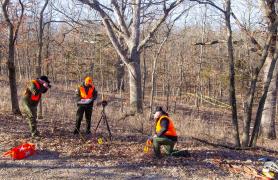The Ozark forests host their own nightly symphony during the growing season, featuring different movements as the months progress. When I grew up in rural southern Missouri Ozarks without air conditioning, my bedroom window was always open at night, and I learned to love the nightly serenade and slept well — no need for “white noise” devices.
This evening harmony is iconic to those growing up in the Missouri Ozarks. As sunset nears, chirping spring peepers provide the opening bars of the music, hesitant at first and then expanding into full chorus, welcoming spring. As temperatures warm, the depth of the music swells dramatically. The rhythmic percussion of katydids pulsates through the canopy. Cicada calls rise and fall in volume, almost in unison. Added in is the progression of amphibians — American toads, southern leopard frogs, and bullfrogs — adding the background chords.
Suddenly, the lilting melody of the symphony is heard ringing above the din: whip-poor-WILL or chuck-will’s-WIDow. These calls repeat over and over, with 50–100 repetitions, and sometimes exceeding 1,000 (whip-poor-will) and 800 (chuckwill’s- widow) consecutive calls.
This melody comes courtesy of two birds named after their raucous calls — the eastern whip-poor-will and chuck-will’s-widow.
If you are close enough to hear the complete call of an eastern whip-poor-will, you will hear a very crisp “cluck” just before the “whip-poor-will.” The bird is named for the portion of the call most people hear, but getting close enough to hear the cluck is like getting close enough to a strutting gobbler to hear the low frequency drumming — you never forget it.
A close cousin, the chuck-will’s-widow also sings its name during the early night and early morning hours. The calls of these birds are as much a part of the Ozark summer landscape as burr oaks, katydids, and spring-fed streams.
Meet the Nightjars
Both birds, members of a family known as nightjars, feed heavily on flying insects after dark and just before daylight with the aid of unassuming small delicate bills that open to reveal large, gaping mouths. This maw scoops up beetles, large moths, grasshoppers, mosquitoes, and other insects while flying through their habitats. Chuck-will’s-widows, the larger of the two species, has even been seen occasionally eating small birds and bats. Both species also have long, stiff feathers surrounding their mouths that help guide prey into their mouths. Long, rounded wings produce buoyant, agile flight that allows them to navigate wooded habitats at night and pursue fleeing insects by making rapid, even 180-degree, turns or flying nearly vertically. Moonlit nights provide opportunity for night-long feeding and extended serenading.
Both birds are cryptically colored with brown and gray mottled plumage, providing excellent camouflage while on the ground in vegetation. The chuck-will’s-widow is tan, has a larger, blockier head with a tan line bordering its brown-red throat. The whip-poor will has a white band below a black throat, a rounder, smaller head, and white (male) or buff (female) corners on its tail. In flight, the male whippoor-will’s tail often flashes with the white outer feathers. These nightjars are seldom seen flying in open sky and foraging, like their cousin, the common nighthawk. Rather, they forage in erratic flight near wooded cover. Both species perch on the ground, logs, or tree branches. Chuck-will’s-widows will sometimes use natural tree cavities or a hollow log for shelter. When flushed, they fly silently with light, mothlike wingbeats. If flushed from incubating their eggs or brood, adults will flop on the ground nearby and fake a wing injury to lure potential predators away from their vulnerable eggs or young.
The Missing Soloists
Having the opportunity to hear a complete rendition of this Ozark symphony is becoming more difficult. The most notable omissions are the soloists, these vocal nightjars. Many Missourians who grew up lying awake at night are noticing their absence, especially in the northern and central portions of the state. Both birds’ worldwide populations have declined dramatically — 63 percent for the chuck-will’s-widow and 69 percent for the eastern whip-poorwill — in the last 50 years, according to the Breeding Bird Survey. One-third as many birds are breeding in the U.S. as there were in 1970. In any symphony, the loss of the lead instrument is unacceptable, and the loss of these iconic birds is no different. The full impact of losing this many insect-eating birds across the state is unknown, as natural systems are complex and hard evidence of declines is difficult to identify and describe. To many of us who love the Ozarks, the decline of these birds goes much deeper, touching our heritage and connection with who we are and where we live.
Although the specific causes of these birds’ declines are not completely understood, the most common culprits are the loss of habitat and potentially widespread pesticide use, especially in the northern half of the state. “Whips and chucks” nest in shortleaf pine or oak-hickory wooded habitats with fairly open canopies. This open canopy allows sunlight to reach the forest floor and grow herbaceous vegetation on the ground level. The birds use openings in the forest cover for foraging at night and seem to favor sites with a history of prescribed-fire management, which clears brushy areas that the birds seem to avoid.
Large amounts of Missouri’s woodlands have been converted to pasture, housing developments, and other uses that make them unsuitable for their former inhabitants. Much of the remaining forested land has grown a closed canopy with little forest management and thus, very little light reaching the ground. Grazing open woodlands removes the necessary herbaceous vegetation that would have otherwise provided valuable habitat. These conditions provide very little open, suitable wooded habitat for either nightjar.
Because both species lay their eggs on the ground without constructing a nest, the quality of the habitat is crucial for survival of the nest and young. Incubation time is about 20 days, and it takes about another 20 days before the young will be able to fly and escape predators. The young hatch as semi-mobile, tan balls of downy fluff that huddle together on the leaf litter and vegetation. During all this time, remaining motionless and blending in with good habitat protects them from predators’ prying eyes. Too little good ground cover leaves them exposed and vulnerable to predation.
Missouri is Important for Whips and Chucks
Missouri hosts a large proportion of the breeding population of both chuck-will’s-widows and eastern whip-poor-wills. The Central Hardwoods Bird Conservation Region, which includes Missouri’s Ozarks and parts of Oklahoma, Arkansas, Illinois, Indiana, Tennessee, Kentucky, and Alabama, contains about 11 percent of the world’s breeding population of chuck-will’s widows and 30 percent of the planet’s eastern whip-poor-wills. If these species fail to thrive here, there is real risk that the keynote melody to the summer-night symphony in Missouri and eastern forests may be lost. While chuck-will’s-widows only breed in the Ozark region of Missouri, eastern whip-poor-will breed in forested habitats throughout the state, except for the bootheel. National bird plans consider Missouri critical to the conservation of these species and the new Missouri Bird Conservation Plan places high priority on these species for attention in savanna, woodland, and young forest habitats.
Helping the Nightjars
The need is critical, so opportunities to help nightjars and the woodlands on which they depend are many. Restoring or managing Missouri woodlands help a broad suite of bird species in addition to others wildlife like white-tailed deer, wild turkey, and even black bears. Many landowners manage for healthy woodlands and sustain wildlife populations while also benefiting their land-use objectives.
Manage Your Land
Good woodland habitat management is crucial to the survival of the eastern whip-poor-will and chuck-will’s-widow. Well planned tree harvests and prescribed fires open the canopy and encourage the growth of diverse, native herbaceous plants while limiting growth of dense shrub thickets. Tree harvests also create scattered openings that benefit nightjars and many other species of birds and wildlife, and help rejuvenate the tree stand when done with a proper plan.
Varying the frequency of harvest or prescribed fire helps produce a wider variety of conditions, favoring a diversity of species. Application of treatments likely will depend on local conditions of the terrain and the vegetation characteristics. For example, a dense stand of pole timber may need more frequent thinning or fire to achieve the desired open canopy with herbaceous ground cover than a mature woodland that already has a structure very close to desired conditions.
Assistance Available
You can receive professional assistance in managing your wooded habitats to help these birds and other wildlife, improve forest health, or other objectives you may have by talking with a MDC private land conservationist or forester. Contact your local regional office (short.mdc.mo.gov/ZwC), and they can help you get in contact with the appropriate professional. You may receive information, technical assistance, and advice on managing the habitats and wildlife on your property to achieve your objectives and meet the needs of the resources and species that occur on your land. Watch for announcements on prescribed fire trainings in your area to learn how to use this important tool to improve your habitats in a safe manner.
Be a Citizen Scientist
Citizens can also help track nightjar populations by participating in the United States Nightjar Survey (nightjars.org), coordinated by the Center for Conservation Biology at William & Mary College. Data collected from the survey provides valuable information on distribution and population trends to aid conservation efforts.
Landowners and birdwatchers can track their birding observations through the eBird app (ebird.org) and contribute their observations to a massive database of bird sightings worldwide.
Whether you experienced an eastern whip-poorwill calling outside your bedroom window growing up or not, our Ozark nightjars are declining and need our help. If you have the capacity, consider ways to help them by managing your land for habitat. The lead vocal in our nocturnal Ozark symphony depends on it.
Statewide Plan Focuses on Bird Decline
In September 2019, an article in the journal Science used long-term bird monitoring data to estimate a net loss of 2.9 billion, or about 29 percent, of our North American birds since 1970. The Missouri Bird Conservation Plan highlights our state’s most threatened bird species and broad management guidelines by species for land managers on both public and private property. Eastern whip-poor-wills and chuck-will’s-widows both made this list. The plan, which was created by conservation agencies and organizations across the state with technical expertise on bird response to management and long-term
Research - MDC staff can help research the resources on your property and understand your management objectives. Plan - They can help you develop a plan to manage your property to enhance habitat and wildlife resources to meet your objectives, which often include production goals. Execute - Staff can help you with training or finding contractors to accomplish the work in your plan, so you can realize














Also In This Issue


And More...
This Issue's Staff
Editor - Angie Daly Morfeld
Associate Editor - Larry Archer
Staff Writer - Bonnie Chasteen
Staff Writer - Heather Feeler
Staff Writer - Kristie Hilgedick
Staff Writer - Joe Jerek
Art Director - Cliff White
Designer - Shawn Carey
Designer - Les Fortenberry
Designer - Marci Porter
Photographer - Noppadol Paothong
Photographer - David Stonner
Circulation - Laura Scheuler






















